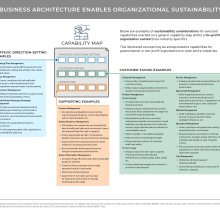This installment of StraightTalk is the first in a series that focuses on how business architecture can be used to catalyze, embed and enforce key sustainability, legal and ethical considerations into an organization’s DNA. Using business architecture in this way truly unlocks its value and power.
First up in our series: how business architecture can enable organizational sustainability, so here goes.
What exactly does sustainability mean?
According to the United Nations Environment Programme (UNEP) sustainability (or sustainable development) is defined as:
“Meeting the needs of the present without compromising the ability of future generations to meet their own needs.”
Sustainability typically includes three components:
- Social (People) – The fair and equitable treatment of people
- Environment (Planet) – The responsible use of natural resources and minimization of environmental impacts
- Economics (Profit) – The economic value created by the organization
This means then that an organization should commit to all three components in order to help address the needs of the society, aim to protect the environment, and focus on providing the best standard of living while still remaining competitive in a world market. And, organizations can measure their performance and value more holistically using the Triple Bottom Line, which includes not just financials but also social and environmental metrics to understand the full cost and benefits of doing business.
Sustainability should not be an afterthought or a set of isolated or superficial programs – but rather embedded in the DNA of how an organization thinks, acts and operates.
Addendum – 19 August 2019
A related note of great news: The influential association, Business Roundtable,* redefined the purpose of a corporation. The purpose includes delivering value to customers, investing in employees, dealing fairly and ethically with suppliers, supporting the communities in which organizations work, and finally – but no longer principally – generating long-term value for shareholders.
We applaud this declaration of intention as a major step and look forward to seeing the action and measurement that needs to follow. We believe this announcement underscores the important themes discussed in this StraightTalk post and the critical role business architecture plays in helping organizations shift their priorities to achieve both purpose and profit. For more on this announcement, please read America’s CEOs Seek a New Purpose for the Corporation.
*Business Roundtable is a non-profit association consisting of Chief Executive Officers from nearly 200 of America’s most prominent companies.
And why does it matter?
Because a sustainable organization is one that can succeed and last. Don’t think about sustainability as some sort of bright-eyed do-goodery, but rather competitive strategic advantage. A sustainability lens helps organizations to be proactive such as by creating new product offerings, new markets, and new ways of capturing the hearts and minds of customers, employees and the public – as well as reactive such as by enabling better responses to regulatory requirements or risks due to climate change and other environmental or social challenges.
For example, here are some relevant excerpts from Larry Fink’s (Chairman and Chief Executive Officer of BlackRock) 2019 Letter to CEOs on Purpose and Profit:
“…every company needs a framework to navigate this difficult landscape, and that it must begin with a clear embodiment of your company’s purpose in your business model and corporate strategy. Purpose is not a mere tagline or marketing campaign; it is a company’s fundamental reason for being – what it does every day to create value for its stakeholders. Purpose is not the sole pursuit of profits but the animating force for achieving them. Profits are in no way inconsistent with purpose – in fact, profits and purpose are inextricably linked.
…One thing, however, is certain: the world needs your leadership. As divisions continue to deepen, companies must demonstrate their commitment to the countries, regions, and communities where they operate, particularly on issues central to the world’s future prosperity. Companies cannot solve every issue of public importance, but there are many – from retirement to infrastructure to preparing workers for the jobs of the future – that cannot be solved without corporate leadership.
…As wealth shifts and investing preferences change, environmental, social, and governance issues will be increasingly material to corporate valuations.”
Profit and purpose can coexist. Any organization can be sustainable.
In the bigger picture though, sustainability is about the survival of our world and ourselves. Check out the United Nations Sustainable Development Goals (SDG) for a global perspective on our collective social and environmental ambitions. And as successful entrepreneur, environmentalist and author Paul Hawken reminds us, business can have a tremendous impact:
“Business is the only mechanism on the planet today powerful enough to produce the changes necessary to reverse global environmental and social degradation.”
So how can business architecture help an organization to become more sustainable?
Since business architecture provides a set of business blueprints that represent the entire organization at a high level, it is a perfect framework for assessing, improving and infusing sustainability into the right conversations and the very fabric of the organization.
Here are a few examples of how business architecture can help.
- Measure, Improve and Create Transparency – Organizations need a framework to assess, analyze, monitor and communicate sustainability performance in order to improve (what gets measured gets managed). Voila, business architecture as an enterprise-wide framework, especially capabilities and value streams, is perfectly suited to help. Sustainability metrics and considerations can be tied to capabilities (and value streams) to ensure that the measurement is framed and communicated within a shared business context and priorities. For example, an Asset Management capability within a corporate vehicle context would, of course, have standard metrics such as Average Utilization of Fleet Vehicles (Days Per Year), but environmental and social metrics could be captured as well to round out the perspective, such as Total Carbon Dioxide Emissions From Fleet Vehicles (Tons Per Year) or Average Efficiency of Fleet Vehicles (Average Actual Miles Per Gallon). Sustainability improvement opportunities can be identified at a high level using the business architecture (e.g., targeted capabilities) and then other teams such as business process or Lean teams can do their magic to remove inefficiencies or waste.
- Identify New Business Opportunities or Risks – Business architects can help identify new sustainability-related opportunities with business model, value stream, capability or other architecture-based innovation. For example, an opportunity to shift a product offering into a service (and facilitate the sharing economy) may be identified. Or, an opportunity to reuse an asset in new ways where it would otherwise be disposed of may be identified. On the other hand, business architects can help to identify sustainability-related risks. For example, capabilities most at risk of climate change impacts or other environmental or social issues could be identified and analyzed.
- Make Sustainability Top of Mind – Business architecture is the great connector, especially capabilities and value streams. So for example, if an organization has sustainability metrics and considerations tied to each capability (and value stream), and if all initiatives are framed by the value streams and capabilities impacted, then it becomes a natural trigger to make sure that sustainability is not negatively impacted with intended changes (or that opportunities to create a positive sustainability benefit can be leveraged). Sustainability is hard to manage well in silos, so business architecture facilitates the big picture. Business architects are also fantastic dot connectors, so they can bring sustainability considerations into the right conversations at the right times as well. (More in Post No. 53.)
- Translate Sustainability Strategies Into Execution – Of course, you were expecting this one. Translating strategies into action in a coordinated way across an organization is at the heart of what business architecture does. (More on that here in Posts No. 3, No. 50 and No. 9.) Many organizations initially create targeted sustainability strategies to help them transform towards their sustainability visions and goals. Business architecture can be a key enabler to make them a reality. However, once the transforming is done, sustainability should be fully embedded in every aspect of how the organization does business – not a standalone strategy or program.
- Architect Ecosystems – Turns out nature is really smart. In nature, nothing is wasted, and in fact waste = food. This same principle can apply to organizations with a concept of Industrial Ecology (the study of material and energy flows throughout industrial systems) where the “waste” of one organization (e.g., excess steam) can become a valuable input for another organization (e.g., a source of energy or heat). And, business architecture is perfectly suited to find these opportunities by modeling and analyzing value streams and value networks that cross organizational boundaries. (More on architecting ecosystems here in Post No. 53.)
Here is a diagram that offers sustainability consideration examples within an enterprise capability context of a for-profit organization.
How can business architects help?
Business architects are perfectly suited to help their organizations become more sustainable. Why? Because business architects…
- Get sustainability and think in systems – they see the whole picture, how the pieces relate and how things play out long-term
- Can balance many different concerns
- Serve as dot connectors between people, ideas and initiatives
- Are leaders
- Are change agents
- Consider all stakeholders including customers, employees, partners, the community in which they operate, the greater society and even future generations
- Work within possibility
- Are wired to care
What next?
Seek out the people within your organization who are responsible for sustainability. For example, this could be a targeted role (e.g. Head of Sustainability), included within Corporate Social Responsibility (CSR) or potentially distributed across functions (and potentially not coordinated). Let them know how you can help. And just start doing it (even if no one picks you, pick yourself).
More Good Stuff…
Larry Fink’s 2019 Letter to CEOs on Purpose and Profit (BlackRock): A must-read and call-to-action by Chairman and Chief Executive Officer of BlackRock.
Global Reporting Initiative (GRI): An absolutely fantastic resource. Check out the standards if you’re looking for ideas of sustainability metrics.
B Impact Assessment: A leading tool any organization can use to measure its impact on its workers, community, environment and customers.
The Natural Step: A framework for achieving sustainability leveraged by corporations, municipalities, academic institutions and not-for-profit organizations.
Green to Gold (book by Esty and Winston): An absolute classic on how to use environmental strategy to innovate, create value and build competitive advantage.
Danone Rethinks the Idea of the Firm (The Economist): A revolution in the food industry and more.
The Future of Management is Teal (Strategy + Business): Organizations are moving forward along an evolutionary spectrum, toward self-management, wholeness, and a deeper sense of purpose. The article asserts that a new form of organization is emerging that is a living organism – which makes most of today’s organizations look painfully outdated.
Business Architecture For Non-Profits and Small Organizations (S2E): A short presentation on how business is evolving and how intentionally architecting organizations can help them to start and scale successfully, including a case study.
Natural Capitalism (book by Hawken, Lovins and Lovins): How today’s global businesses can be both environmentally responsible and highly profitable. Originally groundbreaking. Still is.
The Ecology of Commerce (book by Paul Hawken): A compelling vision of the restorative (rather than destructive) economy we must create, centered on eight imperatives.
Cradle-to-Cradle: Remaking the Way We Make Things and The Upcycle: Beyond Sustainability: Designing For Abundance (books by Braungart and McDonough): Visionary pieces on a new approach to products.
United Nations Environment Programme and Sustainable Development Goals Knowledge Platform (UN): Amazing vision and content from the source.
A World Without Waste (TED Talk): An innovative talk by Kate E. Brandt, Head of Sustainability at Google, on her plan to green up Google by creating a circular economy which reuses, recycles and eliminates waste altogether.

